I just returned from guiding a wildlife expedition for Natural Habitat Adventures in Malaysian Borneo. The diversity of mammals, birds, insects, reptiles and amphibians that we encounter on these trips is utterly mind-blowing, but the superstar is always the orangutan. Our itinerary now includes 2 rehabilitation centers that get up close and personal to semi wild individuals and two wilderness habitats to view and photograph wild ones. This trip was by far my best one yet for experiences with the awe-inspiring “man of the forest.”
Semenggoh Rehabilitation Center-
Located near the small city of Kuching in the state of Sarawak, Semenggoh was established in 1975 as a “halfway house” for orphaned and injured orangutans allowing them to regain their health and skills and once again become wild. Rehabilitated orangs can move freely into the Semenggoh Wildlife Sanctuary, but can come in for supplemental feeding if they choose. The program has been so successful that the Sanctuary has reached its carrying capacity, and independent orangs are now moved to other protected areas of Sarawak.
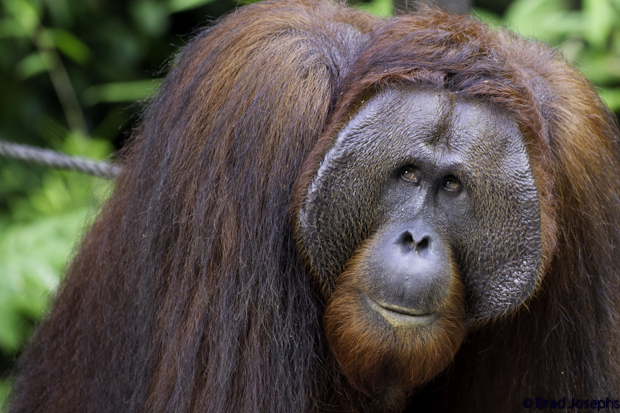
My closest opportunities with huge Alpha males are always at Semenggoh. When this guy emerges from the forest people must clear out of his way. It is thought they are around 7 times stronger than a similarly sized human, and he weighs around 220 lbs.
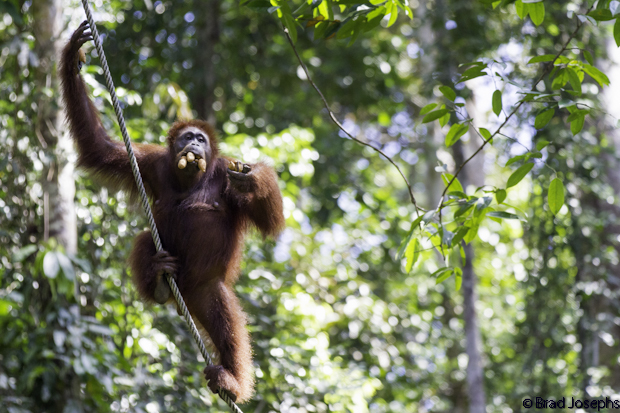
A young male orangutan grabs his lunch and heads for the canopy.
Located near the town of Sandakan in Sabah, Sepilok Orangutan Rehabilitation was established in 1964. Around 20-30 orangutans visit the feeding stations regularly, and around 80 wild orangutans inhabit the surrounding virgin rainforest of the 10,000 acre Kabili-Sepilok Forest Reserve. Our group was ecstatic to view a female named Maraco, and her 3 week old newborn. The reproductive rate of orangutans is extremely slow as females give birth to only one baby every 7 years. Females are fertile between the ages of 15 and 35 years of age, so they usually only have 2 or 3 offspring in their lifetime! Between the ages of 1 and 4, the babies hold onto their mother’s shaggy hair. Between 4 and 7, the young will climb on their own, but follow their mothers closely.
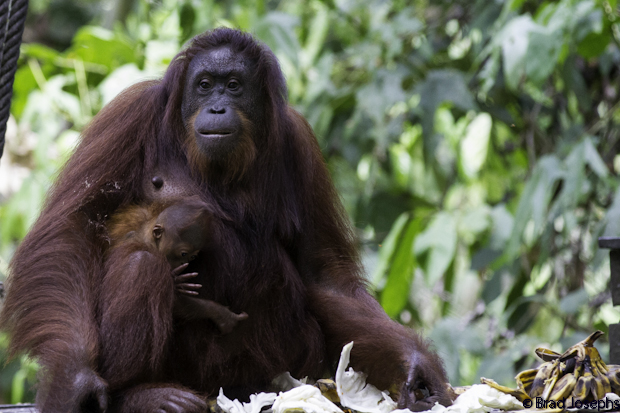
One of our trip highlights was seeing this female with her 3 week old baby orangutan at Sepilok.
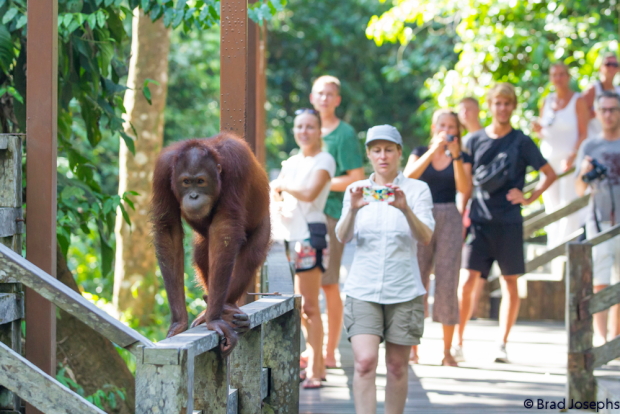
There are no fences at the rehab centers, so close encounters with orangutans are nearly guaranteed. People must keep a respectful distance or they lose their cameras, clothing or worse!
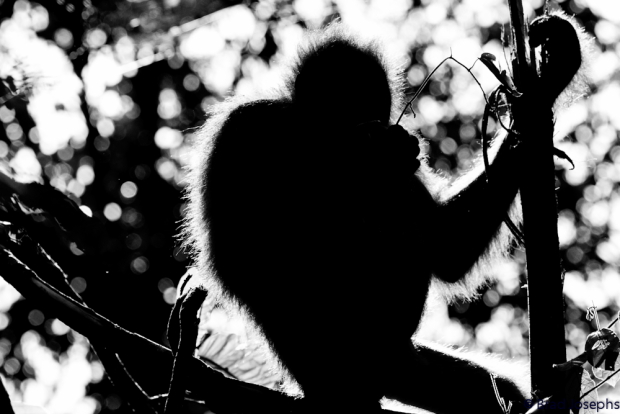
A male orangutan stares down from the canopy at sunset. I chose black and white to add to the mystery of being in the presence of an animal with such an eerie similarity to humans.
Danum Valley Conservation Area
The last stop on our expeditions is Danum Valley, a remote, extremely wild region of southern Sabah. This is arguably as pristine and diverse as any wilderness on Earth. This is one of my favorite places on Earth. We had several encounters with wild orangutans as we explored the trail system on foot with the help of our expert local naturalist guides. The most memorable encounter, which ranks high in my own personal wildlife experiences of my lifetime, was watching the regions dominant male, named Ali Baba, courting a young female. We waited over an hour for them to wake from a nap in the crook of a tree before we were awarded with some amazing views.
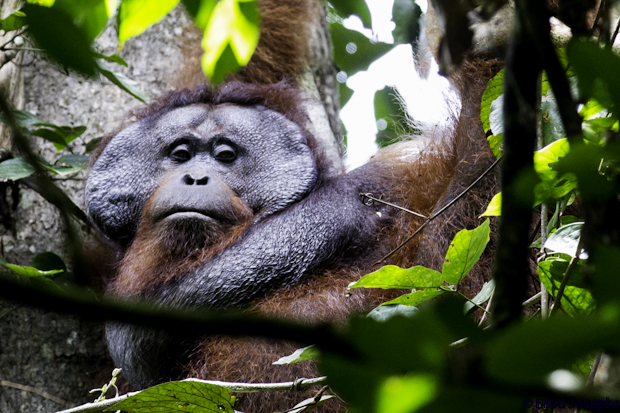
Ali Baba is a giant Alpha male in the Danum Valley with an estimated weight of 260 lbs! Males who become dominant mysteriously grow wide cheek pads, called phalanges, and huge neck pouches to help them broadcast calls.
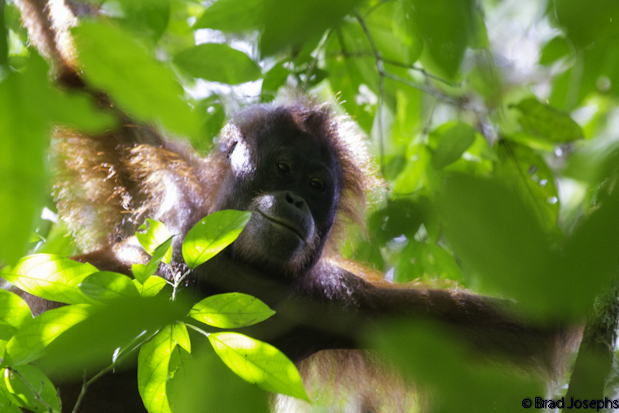
This is Ali Baba’s girlfriend. She is very young and cute, and this was her first romantic encounter in her life!
The next day we came upon a mother and her 5 year old daughter. She was big enough to climb on her own and she hung from a branch for 30 minutes with one hand about 70 feet above the ground munching on young leaves. I was apparently much more concerned for her safety then her mother.
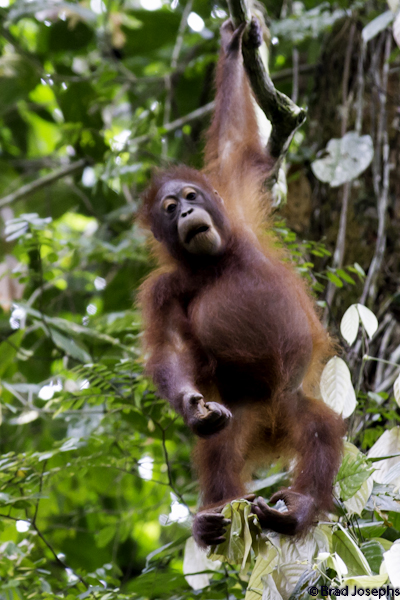
The hand strength of orangutans allows them to easily hang from vines or branches for extended periods of time. I have never heard of them falling and injuring themselves.
Stay tuned for more tales of Borneo’s wild creatures in the near future!

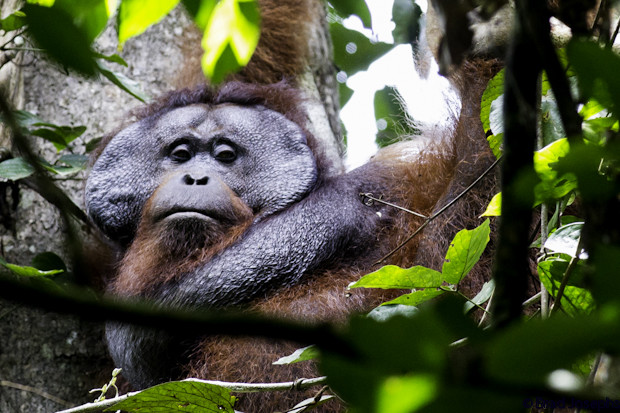

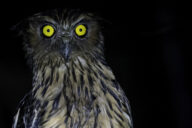
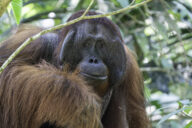
3 Comments
I loved seeing your blog and pictures. What a great trip. I am jealous.
Brad, does Natural Habitat have any plans to go to Sumatra?
Hi Brad….My name is James Ritchie. I’m a local 70 year old journalist of 48 years. I rescued a male Orang Utan which has been named after me from a poacher at the Batang Ai National park 30 years ago in December 1989. My “son” Ritchie now weighs 120kg is . I’m in the process of publishing a book on a collection of Orang Utan stories. Some are very sad, some amusing and others hilarious!
I intend to raise funds to preserve Orangutan habitats in Sarawak and hope I get support from members of the public. Please keep in touch if you are heading to Borneo anytime soon! Cheers and Merry Christmas in advance.
Unka—Our Orangutan Cousin in the Longhouse
———————————————————-
On August 19, 1963 I visited Rh. Jawi at Ulu Ensering, a 37-door longhouse, the farthest along the Kanowit River, and that was when I met “Unka”. I had journeyed along the Kanowit river for five days before reaching Rumah Jawi at 730 p.m.
The sound of the longboat engine must have attracted the occupants as I saw a group of persons coming down to receive us at the landing point. I was with four other policemen. Using torch lights to guide us, the locals were going to put us up for the night.
“Unka” with long red and hairy arms, wearing black trousers and a small hat on, took me by my hand as we entered the longhouse. He could not talk but introduced himself by grunting “Unka”. So the people gave him the name “Unka”.
Tired and hungry and exhausted after the long journey, I did not bother to look at Nuka’s face as he carried my bags to the longhouse. We had a short rest before taking our bath. Unka had a pail in his left hand and carried a soap with his right hand which he passed to me. It was dark and I was tired.
After we were entertained at the Common Corridor (Ruai). During the dancing I was attracted by Unka, the performer in red, as his presentation was more graceful than all the others. He became Chief Entertainer. Though sleepy, I noted that Unka’s skill in the “Ngajat” (a traditional Iban war dance) was excellent. No female performers could match him in movements as he imitated the movements of monkeys and other animals in the forest including birds and our hornbills.
Happy with his performance, the occupants offered Unka with tuak and cigarettes. He did not stop dancing and continued with his performance by holding a glass of tuak on his left hand and cigarette in house mouth. The beating of the gongs by the ladies which Unka was familiar with, encouraged him to come up with all the styles that made every body happy that they laughed until tears streamed down their faces. When he stopped dancing, all the ladies rushed to him and shook his hand.
Groggy after the exhausting boat ride, I put my head on the pillow outside TR Jawi’s room and soon dozed off soon after the crowd had dispersed. So deep in my sleep I did not know that Unka was sitting by my side until his hand touched mine. Cold and hairy, I jumped up thinking that a real ghost, was holding my hand. I said: ““Apa itu? Apa itu?” (What’s that? What’s that?). Then I noticed for the first time that Unka was not of the Homo Sapiens species but an Orangutan, our distant cousin from the Jungle.
That morning Unka sat by my side as we had breakfast the next morning. Over breakfast TR. Jawi told me that the primate was caught by a group of hunters at Ulu Lanjak across the Indonesian border after he fell down from his mother’s arm when she was shot. Unka had lived in the longhouse for more than 20 years, and. everyone in the longhouse loved him.
Before leaving Ulu Ensering, I garlanded Unka with a silver necklace with my name tag “LAWRENCE”. As I write it has been almost 40 years since I last met Unka. When Robert, my only son, studying in Melbourne between 1983-1989, I visited him and made contact with some of his Australian friends and told them about my meeting with the Orangutan. Even Rev Fr Vos was fond of Unka. On 7th Feb 2003, I wrote to an Australian friend Malcolm and said:
“The wild life society should acknowledge the good deed Unka had displayed. We dare not come out with publicity for fear that Unka might be sent back to his home land (The Lanjak and Entimau wildlife Sanctuary) which is just a days walk from where Unka lives now.
Though Unka is not a human being, the dwellers of Rh Jawi, about 400 of them, would surely protest when if is physically removed (by the Forestry Department).
Knowing Prince Philip of England, whom I met in 1970 while I was with the M15, London, is the Chairman of the Wildlife Society for the Commonwealth Countries, perhaps, we should consider writing to him with our plea that Unka be given freedom and be allowed to remain at Rh Jawi for the rest of his life.
Imagine, had it not been for Unka who alerted the occupants of Rh Jawi, death would have been caused by a flash flood. It was the worst flood ever happened. The authority should go after RH, WTK, KTS and all other giant timber logging operators for destroying the nature that caused the flood.”
Despite writing the letter, I later changed my mind and did not post it. I am sure my friend, Bill Tan, who knows both Prince Philip and Dr.Philips of England will be sympathetic when I show him my account of the story. Let him speak to either one of the Philips.
On Jan 26, 2003, my birthday ,I though of Unka the Orangutan. He would be 59 years old. He was 20 years old when I first met him,. younger to me by six years, as I was 64 years old at that time.
It is heartening to learn from my uncle who lives in Pakan that Unka was baptised by Rev Fr Vos some 15 years ago and given the name “Lawrence”. I was also told that my necklace with Unka was still intact.
I was also told that Unka was taken in by Rev Fr Vos and was looking after the Chapel next to Rumah Jawi. He helped to beat the gong every Sunday morning, while wearing a white frock, to invite the occupants of Rh Jawi longhouse to come to attend the Mass. He swept the floor, arrange chairs and tables inside the Chapel. Compared to the longhouse, Unka appeared happier living inside the Chapel as there was no disturbance by children and dogs.
At noon January 13, 2003 the occupants of Rh Jawi noticed that Unka was behaving in a rather unusual manner. They saw him carrying a log to the Chapel and as night fell he was seen carrying a pressure lamp back to the Chapel. Curious, the Chief of the long house saw Unka climbing up the roof of the Chapel and hanging the lamp by the side of the Cross. “It is a Holy Night for Unka”, the longhouse thought and they too prayed at the church before retiring to bed.
Suddenly there was a beating of gongs as a storm was brewing. Flash floods hit the longhouse within a short time and the water rose up to 50 feet, reaching the floor of the longhouse. It then rose to 60 feet and everybody was struggling as they climbed onto the roof. Being on top roof of the Chapel on the hill, Unka was safe. Strange but true, the villagers saw Unka waving to the children to swim to the foot of the hill and join him at the Chapel.
In fact, Unka remained standing by the side of the Cross after the storm apparently showing the sign of the cross–by placing his right palm on his fore head, his heart, left and right shoulder. Children, young and old followed him with the sign and went up and joined him.
The floods were so bad that even Pakan and Julau, far way down river, was under eight feet water. The floods subsided January 16, 2003. Coincidentally, my reporter friend James Ritchie who had rescued and surrendered another Orangutan in the Batang Ai region sometime in 1990, called me I switched off my hand phone.
.I was afraid that he would write the article about Unka and the forestry department would remove the primate which would be a sad thing.
I thought to myself that one day I would contact Rev Fr Lawrence Chua in Kuching and tell him about the three good and holy Lawrence’ of Sarawak—Datuk Lawrence Chua, myself Lawrence Unka the Orangutan.